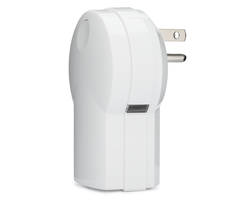Make Your Holiday Season Merry With a Z-Wave Christmas Tree!
Posted By Michael GorisIf you recall last week, we put out our 2020 holiday buying guide for smart home automation. Today, we wanted to focus on a very small aspect of that buying guide and explore some quick possibilities on how your can use some smart automated plug-in modules around the holiday season.

Plug-in modules couldn't be more convenient. You simply plug one into your standard outlet, enroll it with your smart home network (we like Z-Wave Plus), and connect the device(s) you want to control. And just like that, you can take virtually any connected device, and turn it into a smart device. The possibilities around the holiday season are particularly cool.
But before we get into some creative ways to use your plug-in modules, let's take a look at a few of our favorites. You should recall all of these from our buying guide if you read through that, but it never hurts to reintroduce them.
- Linear PS15EMZ5-1 Z-Wave Plus Plug-In Appliance Module
- Resideo Z5SWPID Z-Wave Plus Plug-In Smart Switch
- Qolsys IQ Smart Plug Z-Wave Plus Plug-In Module
And we also want to give an extra special shout-out to the Resideo Z5SWPIO Z-Wave Plus Outdoor Plug-In Switch. Unlike the other three plug-in modules mentioned here, the Resideo Z5SWPIO is the only one that can be used OUTDOORS. This can certainly come in handy around the holiday season with lighting displays set up outside for the world to see. We can imagine many of you out there will want to bring smart automation to the holiday lights you've worked so hard on. You may as well do things right with an outdoor smart plug-in switch!
But across the board, the name of the game here is scheduling. If you want to have your lights turn ON and OFF automatically on a set schedule, then Z-Wave Plus plug-in modules are the way to go. Sure, you could rely on traditional timers and relays, but this makes things so much easier! And assuming you have your plug-in modules set up with your monitored security system, then all of this can be conveniently done through Total Connect 2.0 or Alarm.com. All you need to do is build a smart scene that sets a time for your devices to turn ON, and another for them to turn OFF later on. It's that simple.
Now, let's think about what you can include in these scenes. We'll start simple. How about your Christmas tree? Turn it into a Z-Wave Plus Christmas tree! This can be very nice if you are away from home for the holidays. By having your Christmas tree turn ON and OFF automatically, you can make it appear like someone is home, even if not a creature is stirring. If you have some other electronic holiday gear, then there's a great chance that it can be included in this setup as well.
If you really want to make things extra special, then get that Resideo Z5SWPIO Outdoor Module we talked about earlier, and use it to put your home's entire holiday lighting display on a schedule! Even if you're away seeking warmer weather, you can still have the best holiday display on the block. With Z-Wave Plus technology, you can ensure that your home lights up the cul-de-sac at night, and then safely powers down once morning arrives. You can even set specific scenes for sunset and sunrise to make scheduling a bit more customized.
And you don't even have to stop with the lights. If you have one of those giant inflatable outdoor snowman, then put that on your plug-in module too. As long as you don't exceed the load limit, then you're good to go! A few plug-in modules will really allow you to get wild. And it's all super easy to set up! If you have any questions about automation, then forward them over to support@alarmgrid.com, and we'll be happy to help. Our team is here from 9am to 8pm ET M-F to answer your questions. We look forward to hearing from you!



 The GoControl and Linear brands are often used interchangeably. They are both used to identify automation offerings from
The GoControl and Linear brands are often used interchangeably. They are both used to identify automation offerings from 


